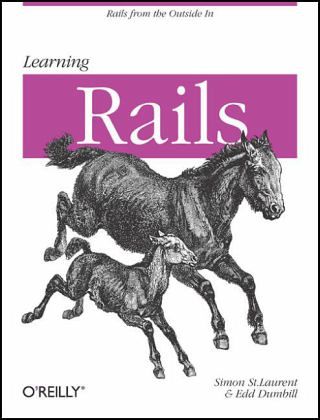Nicht lieferbar

Learning Rails
Rails from the Outisde In
While most books written about Rails cater to programmers looking for information on data structures, Learning Rails targets web developers whose programming experience is tied directly to the Web.
Rather than begin with the inner layers of a Rails web application--the models and controllers--this unique book approaches Rails development from the outer layer: the application interface. You'll learn how to create something visible with Rails before reaching the more difficult database models and controller code. With Learning Rails, you can start from the foundations of web design you already know, and then move more deeply into Ruby, objects, and database structures. This book will help you:
* Present web content by building an application with a basic view and a simple controller, while learning Ruby along the way
* Build forms and process their results, progressing from the simple to the more complex
* Connect forms to models by setting up a database, and use Rails' ActiveRecord to create code that maps to database structures
* Use Rails scaffolding to build applications from a view-centric perspective
* Add common web application elements such as sessions, cookies, and authentication
* Build applications that combine data from multiple tables
* Create simple but dynamic interfaces with Rails and Ajax
Once you complete Learning Rails, you'll be comfortable working with the Rails web framework, and you'll be well on your way to becoming a Rails guru.
Rather than begin with the inner layers of a Rails web application--the models and controllers--this unique book approaches Rails development from the outer layer: the application interface. You'll learn how to create something visible with Rails before reaching the more difficult database models and controller code. With Learning Rails, you can start from the foundations of web design you already know, and then move more deeply into Ruby, objects, and database structures. This book will help you:
* Present web content by building an application with a basic view and a simple controller, while learning Ruby along the way
* Build forms and process their results, progressing from the simple to the more complex
* Connect forms to models by setting up a database, and use Rails' ActiveRecord to create code that maps to database structures
* Use Rails scaffolding to build applications from a view-centric perspective
* Add common web application elements such as sessions, cookies, and authentication
* Build applications that combine data from multiple tables
* Create simple but dynamic interfaces with Rails and Ajax
Once you complete Learning Rails, you'll be comfortable working with the Rails web framework, and you'll be well on your way to becoming a Rails guru.
Learning Rails takes a web-centric approach to the popular web application framework, making it easier to get started.Most Rails books are written for programmers who have already worked in other frameworks. They explain how to handle the inner parts of an application first -- models and controllers -- before moving on to the view. For web developers who know HTML and JavaScript, though, starting with databases is a painful way to learn Rails.This book approaches Rails from the outer layer, letting web designers create something visible before reaching the difficult database models and controller code in the inner layers. With Learning Rails, you can start from the HTML and programming you already know, and then move more deeply into Ruby, objects, and database structures.Once the book gets you up and running, you'll learn how to: Present content by building a simple application with a basic view and a simple controller, while learning Ruby along the way Build forms and process their results, moving from the simple to the complex Connect forms to models by setting up a database, and use Rails' Active Record to create code that maps to database structures Use Rails scaffold to build applications from a view-centric perspective Manage content with Rails using features like routing and layouts Add common web applications elements like sessions, cookies, and authentication Build applications that combine data in multiple tables Test data structures and deploy them to a production environment Create dynamic interfaces with Rails and AjaxBy the end of the book, you'll be comfortable working in Rails. You won't be a Ruby guru, but you'll be ready to take advantage of other resources for becoming one.This approach may test the patience of hardcore programmers. But, while databases and objects may be at the core of web application development, they aren't necessarily at the core of everyone's web application skills. If you'd rather learn Rails from the outside in, working with the more familiar view side of the application, you're in the right place with Learning Rails.




